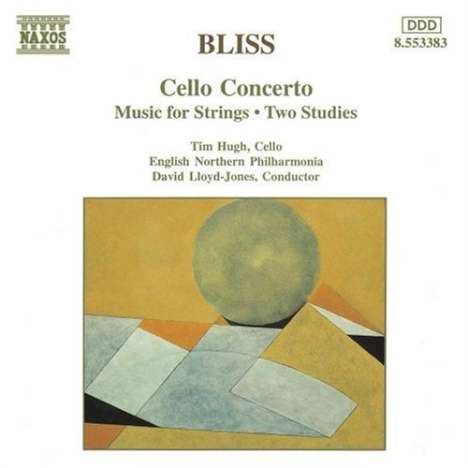Arthur Bliss: Cellokonzert auf CD
Cellokonzert
Herkömmliche CD, die mit allen CD-Playern und Computerlaufwerken, aber auch mit den meisten SACD- oder Multiplayern abspielbar ist.
(soweit verfügbar beim Lieferanten)
+Music f. Strings op. 54; Etüden op. 16 Nr. 2 & 3
- Künstler:
- Tim Hugh, English Northern Philharmonia, Lloyd-Jones
- Label:
- Naxos
- Aufnahmejahr ca.:
- 1995
- Artikelnummer:
- 7854400
- UPC/EAN:
- 0730099438322
- Erscheinungstermin:
- 7.10.1996
Wie es sich für ein klassisches Konzert gehört, gibt es drei Sätze, von denen der erste, bei weitem am weitesten ausgedehnte, auf robustem, ausladendem Material, hüpfenden Intervallen und punktierten, für Bliss charakteristischen Rhythmen beruht, die in verschiedenen Entwicklungsstadien das ganze Werk durchziehen. Das zweite ist zart, vielleicht etwas traurig, ein Wechselspiel von gedämpften Tönen und kleinen privaten Dialogen zwischen Solist und Bläsern, manchmal auch Hörnern. Es ist meist im zusammengesetzten Takt und in Triolen, und es wäre ein Wiegenlied, außer dass es sich nicht einstellen wird. Das dritte ist ein Zusammentreffen von Disparaten, meist athletisch oder puckig, mit fast einem Kabarett von schnellen Stimmungs- und Metrumwechseln und einem kontrastierenden Sostenuto-Abschnitt, der wirklich das Herz berührt, wenn auch sanft - lyrisch, aber nicht sentimental - bevor das Anfangsthema wieder auf uns zurückfällt und eine Vivo-Coda uns zum Schluss bringt, dass "Freude am Schreiben" aus fast jedem Takt herausstrahlt.
Auf den ersten Blick tut das Konzert fast alles, was Solisten hassen: Sie spielen eine anstrengend anspruchsvolle Partie, die das Äußerste an Technik und Finesse verlangt, sehr wenig Gelegenheit zur Selbstdarstellung bietet, aber jede Gelegenheit zu Fehlern bietet. Sie tun dies über einen langen Zeitraum, mit kaum einem Takt Pause, und zum größten Teil stark exponiert. Es gibt viele Tücken, keine Verstecke und sehr wenig Ruhm. Und dennoch habe ich bei keinem einzigen Spieler ein schlechtes Wort darüber gehört.
Product Information
There are three movements, as befits a classical concerto, of which the first, by far the most extended, is based on robust, expansive material, leaping intervals and dotted, characteristic Bliss rhythms which, in various states of development, permeate the whole work. The second is tender, perhaps slightly sad, an interplay of muted tones and little private dialogues between soloist and wind instruments, sometimes horns. It is mostly in compound time and triplets, and would be a lullaby except that it will not settle. The third is a coming-together of disparates, mostly athletic or puckish, with almost a cabaret of rapid mood and metre changes and a contrasting sostenuto section that genuinely touches the heart, albeit gently - lyrical but not sentimental - before the very opening theme bursts back upon us and a Vivo coda precipitates us to the conclusion "joy in writing" shines out of almost every bar.
On the face of it, the Concerto does almost everything soloists hate: they play a strenuously demanding part calling for the uttermost of technique and finesse, offering very little opportunity for display but affording every chance to make mistakes. They do this for a long time, with scarcely a bar's rest, and for the most part severely exposed. There are pitfalls galore, no hiding places and very little glory. And yet, not one player have I met with a bad word to say about it.
Disk 1 von 1 (CD)
-
1 Music for Strings, Op. 123: I. Allegro moderato, energico
-
2 Music for Strings, Op. 123: II. Andante, molto sostenuto
-
3 Music For Strings, Op. 123: Iii. Allegro Molto - Presto
-
4 Cello Concerto: I. Allegro deciso
-
5 Cello Concerto: II. Larghetto
-
6 Cello Concerto: Iii. Allegro
-
7 Study, Op. 16, No. 2: Adagio ma non troppo
-
8 Study, Op. 16, No. 3: Allegro
Mehr von Arthur Bliss







